
 Nick Carter, Master Detective (1943-1955) aired “Monkey Sees Murder” (or “Nick Carter and the Mystery of the Peruvian Red Mark”) on January 7, 1945. This is only the 8th Nick Carter episode we’ve run since 2009, the last being this past December. Carter’s history is long, covers numerous media, and is one of the more fascinating we’ve come upon. To crib from one of our earlier entries for new listeners, and slightly expanded with new material, Nick Carter on radio ran a respectable twelve years, from 1943-1955, but the famous detective’s history begins much earlier. During the post-Civil War era known as Reconstruction, a short story featuring Carter appeared in an obscure fiction paper (The New York Weekly) in 1886 (predating the first Sherlock Holmes story by two years). The publisher was none other than Street & Smith, a fledgling, struggling publishing firm which would later become the most dominant pulp magazine publisher in the world. Among its later titles would be Astounding Science Fiction (now Analog), the only magazine from Street & Smith to survive the pulp magazine crash of the 1950s.
Nick Carter, Master Detective (1943-1955) aired “Monkey Sees Murder” (or “Nick Carter and the Mystery of the Peruvian Red Mark”) on January 7, 1945. This is only the 8th Nick Carter episode we’ve run since 2009, the last being this past December. Carter’s history is long, covers numerous media, and is one of the more fascinating we’ve come upon. To crib from one of our earlier entries for new listeners, and slightly expanded with new material, Nick Carter on radio ran a respectable twelve years, from 1943-1955, but the famous detective’s history begins much earlier. During the post-Civil War era known as Reconstruction, a short story featuring Carter appeared in an obscure fiction paper (The New York Weekly) in 1886 (predating the first Sherlock Holmes story by two years). The publisher was none other than Street & Smith, a fledgling, struggling publishing firm which would later become the most dominant pulp magazine publisher in the world. Among its later titles would be Astounding Science Fiction (now Analog), the only magazine from Street & Smith to survive the pulp magazine crash of the 1950s.
(Cover above left from the April 1936 issue of Nick Carter Detective Magazine)
Award-winning radio historian Elizabeth McLeod notes that, “Within a decade, an ongoing series of Nick Carter novels vaulted [Street & Smith] to the front ranks of dime-novel publishers, and made Nick himself a national institution. Nick’s own magazine, The New Nick Carter Weekly, would carry the detective into the twentieth-century.” By 1915, however, the then titled Nick Carter Weekly became Street and Smith’s Detective Story Magazine, a true pulp magazine and S&S’s initial entry into this new format. Again, from Elizabeth McLeod: “Detective Story Weekly soon became Street and Smith’s flagship publication. With the rise of radio in the 1920s, it became the firm’s entree into the broadcast medium. The Street and Smith Detective Story Hour became a favorite of listeners at decade’s end, with elaborate tales of murder and crime hosted by a mysterious narrator introduced only as “The Shadow.” While Nick Carter himself did not appear on the program, his spirit was very much in evidence in the various detective characters that populated the stories.” Of course, we all know what happened next. The mysterious voice only introducing the S&S Detective Story Hour became so popular that S&S launched The Shadow magazine in 1931, and shortly thereafter S&S added Doc Savage to its pulp adventure line. Amidst all of this activity Nick Carter was even given his own magazine (again) in 1933, proving the character’s resiliency and staying power–he was now 47 years old.
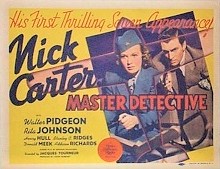
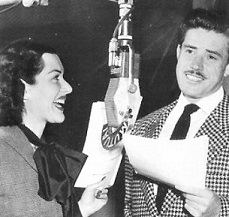 Nick Carter Magazine ran for 40 issues, from March 1933 to June 1936, the final six issues slightly retitled as Nick Carter Detective Magazine. While the magazine had folded, its long-running character still lived, for in 1939 Hollywood picked up the movie rights and produced three “B” Carter films starring noted actor Walter Pidgeon (who later would star in the classic 1956 SF film Forbidden Planet).* A mere three years later, Nick Carter would rise from the dead yet again in his own radio series, Nick Carter, Master Detective. The show’s producer and often the writer, Sherman “Jock” MacGregor, would enlist some of the best writers in the business to script Carter’s episodes, including Robert Arthur and David Kogan of Mysterious Traveler fame, the creator of The Shadow, Walter Gibson, and none other than legendary SF author Alfred Bester (one of which Bester-written episodes, “Chemical Chickens,” we ran in March of 2014 here). Lon Clark played Nick Carter throughout its 12-year run, ably supported by first Helen Choate (pictured at right with Lon Clark, and featured in this episode) and then Charlotte Manson as Nick’s intelligent, perky secretary Patsy Bowen. Other mainstay characters included Police Sergeant Matty Mathieson, young newspaper reporter Scubby Wilson, and scruffy old veteran of the crime game Waldo McGlynn.
Nick Carter Magazine ran for 40 issues, from March 1933 to June 1936, the final six issues slightly retitled as Nick Carter Detective Magazine. While the magazine had folded, its long-running character still lived, for in 1939 Hollywood picked up the movie rights and produced three “B” Carter films starring noted actor Walter Pidgeon (who later would star in the classic 1956 SF film Forbidden Planet).* A mere three years later, Nick Carter would rise from the dead yet again in his own radio series, Nick Carter, Master Detective. The show’s producer and often the writer, Sherman “Jock” MacGregor, would enlist some of the best writers in the business to script Carter’s episodes, including Robert Arthur and David Kogan of Mysterious Traveler fame, the creator of The Shadow, Walter Gibson, and none other than legendary SF author Alfred Bester (one of which Bester-written episodes, “Chemical Chickens,” we ran in March of 2014 here). Lon Clark played Nick Carter throughout its 12-year run, ably supported by first Helen Choate (pictured at right with Lon Clark, and featured in this episode) and then Charlotte Manson as Nick’s intelligent, perky secretary Patsy Bowen. Other mainstay characters included Police Sergeant Matty Mathieson, young newspaper reporter Scubby Wilson, and scruffy old veteran of the crime game Waldo McGlynn.
*(The first of the three Nick Carter films was 1939’s Nick Carter, Master Detective. Of interest to genre buffs is that it was directed by Jacques Tourneur, now famous for directing the following trio of Val Lewton horror films: Cat People (1943), I Walked with a Zombie (1943), and The Leopard Man (1943).)
From Nick Carter’s beginnings in 1886 through his final radio show in 1955, Carter would change with the times; from clean-living detective (actually, at the beginning of his career, Nick was a private investigator and consulting detective to the police department, much like Sherlock Holmes, and did not work as a police detective), master of disguise, to anti-espionage agent, to the bane of mad scientists or the defender of scientists beset by crooks, Nick Carter has enjoyed one of the longest surviving, most popular runs in various media for over 100 years, for when his radio show ended in 1955 he would resurface (yet again!) in a series of James Bond-type paperback novels in the 1960s which ran into the 1990s, quite a few of them written by women.
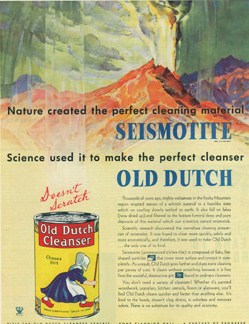 Virtually forgotten today, Nick Carter predates Dashiell Hammett’s Sam Spade, Raymond Chandler’s Philip Marlowe, and was originally inspired by the real-life exploits of private investigator Allan Pinkerton. And though this episode isn’t of the SF genre, one of the show’s sponsors has a product with a decidedly pulpish SF sounding name (which is chuckle-worthy to modern sensibilities). The sponsor is Old Dutch Cleanser and it touts its main ingredient as Seismotite. The ad pictured at right is from 1934 and this radio episode is from 1945, so it looks like Old Dutch Cleanser and Seismotite were enjoying a pretty good run, though their rival, Johnson’s (with a whole line of products including Johnson’s Wax), would eventually prevail.
Virtually forgotten today, Nick Carter predates Dashiell Hammett’s Sam Spade, Raymond Chandler’s Philip Marlowe, and was originally inspired by the real-life exploits of private investigator Allan Pinkerton. And though this episode isn’t of the SF genre, one of the show’s sponsors has a product with a decidedly pulpish SF sounding name (which is chuckle-worthy to modern sensibilities). The sponsor is Old Dutch Cleanser and it touts its main ingredient as Seismotite. The ad pictured at right is from 1934 and this radio episode is from 1945, so it looks like Old Dutch Cleanser and Seismotite were enjoying a pretty good run, though their rival, Johnson’s (with a whole line of products including Johnson’s Wax), would eventually prevail.
In “Monkey Sees Murder” Nick has received a letter from an old friend, a professor he accompanied on an expedition to Peru in his younger days. The professor asks that Nick come visit him on a certain matter, but when Nick arrives at his old friend’s home he finds him dead, shot in the head. With precious little to go on, Nick begins to investigate and one thing leads to another–including more deaths and more unanswered questions. All I can impart here is that the trouble stems from something that took place in that long ago excursion to Peru that has now caught up with the members of the expedition without warning. So listen now as Nick Carter must not only solve his friend’s murder but several others as well, and uncover the mystery of why they had to die.
Play Time: 29:23
{The bitter cold of January 1945 did not deter the neighborhood gang from heading for the corner newsstand, bundled up as they were in their heavy coats, and new stocking caps and scarves courtesy of grandma’s and grandpa’s Christmas gifts (grandparents were always giving them clothes for birthdays and at Christmas). Impressionable as are all youngsters, after listening to this Nick Carter adventure they decided to go with more of the same with their pulps, already purchasing all of their usual SF pulps for January. The Phantom Detective (1933-53) was launched as a response to the popular The Shadow Magazine (which debuted two years earlier in 1931) and proved immensely popular. In 1945 it was a bi-monthly. Thrilling Detective (1931-53) was also popular, and was a monthly through 1944 but cut back during the war a bit. In 1945 it saw ten issues. Ten Detective Aces (1928-47) began as The Dragnet Magazine, then changed to Detective-Dragnet Magazine after 16 issues, but beginning in 1933 had finally become Ten Detective Aces, under which title it ran for a remarkable 16 years. From its first issue in 1933 under its final name until near the end of 1943 it was a solid monthly, but as happened to many another pulp magazine of the time, the war took its toll, and from 1944-49 it became a bi-monthly for the most part, with two years managing only 5 issues instead of 6. In 1945 it was a bi-monthly}
[Left: The Phantom Detective, Feb. ’45 – Center: Thrilling Detective, Jan. ’45 – Right: Ten Detective Aces, Jan. ’45]
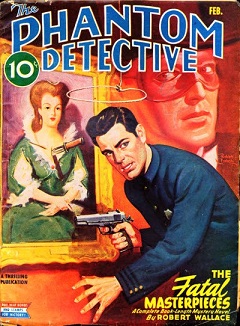

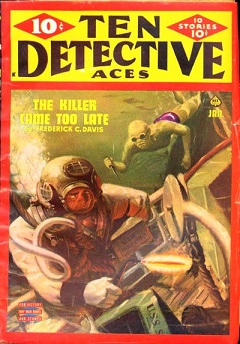
To view the entire list of weekly Old Time Radio episodes at Tangent Online, click here.